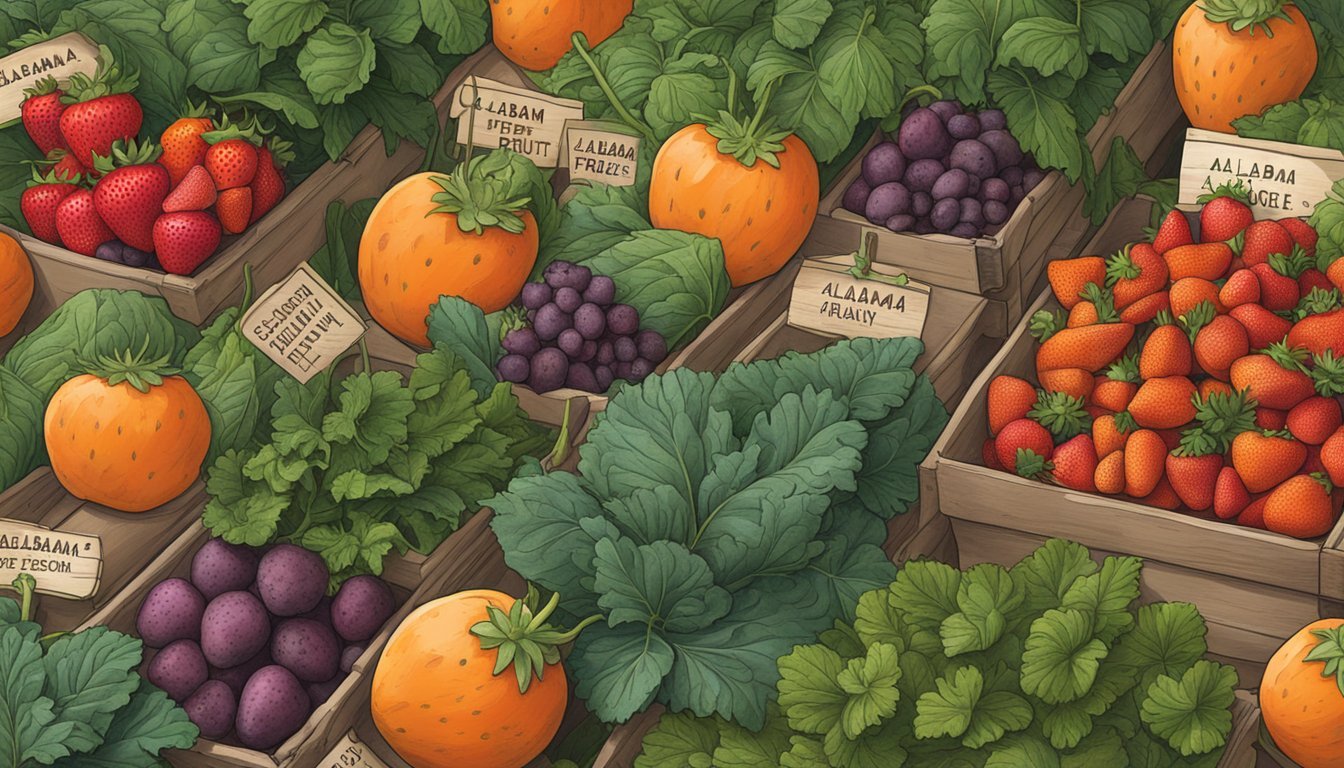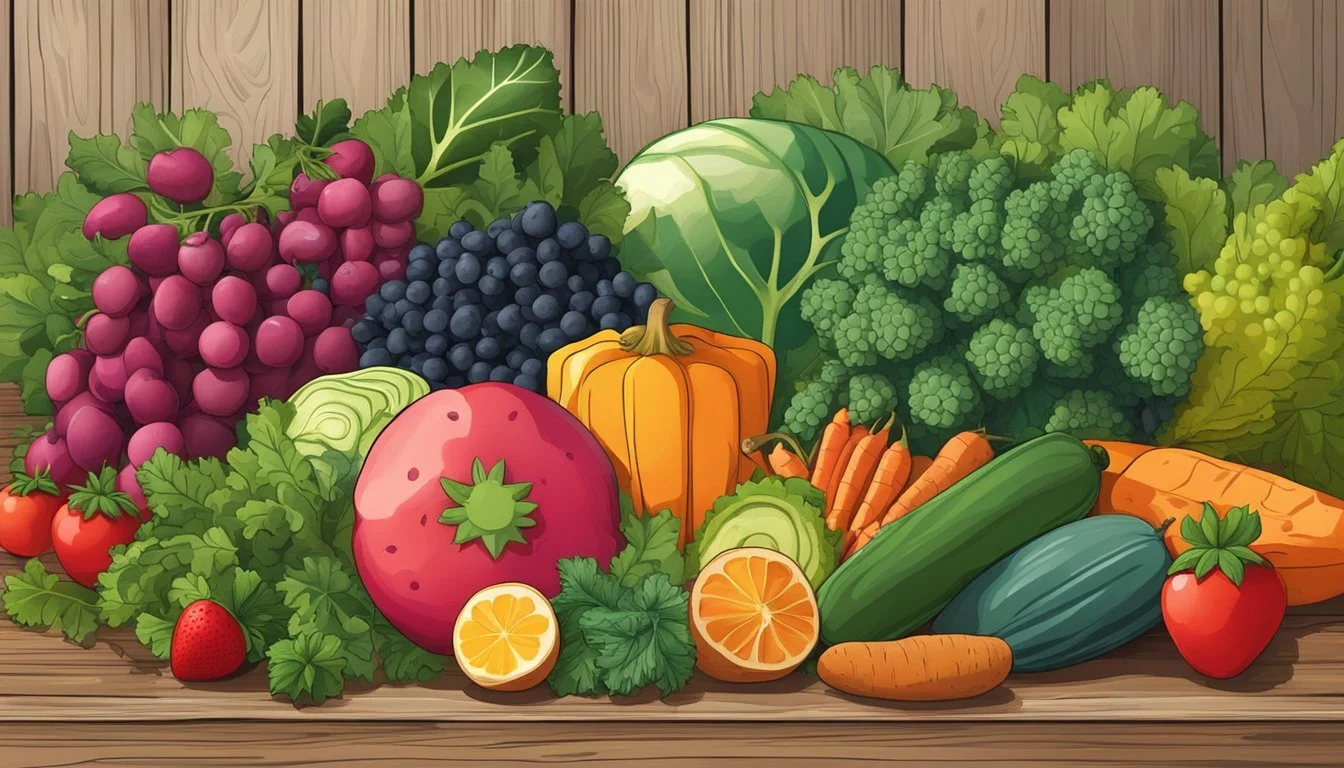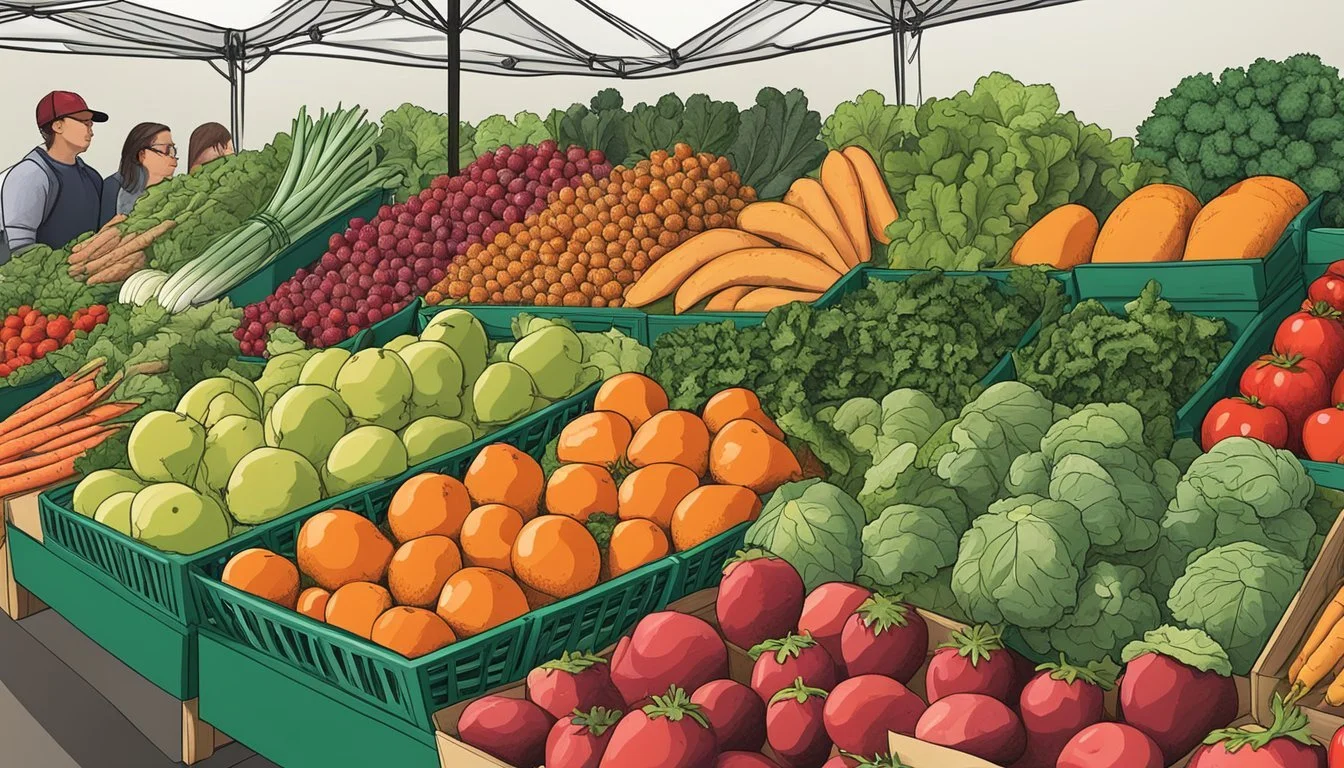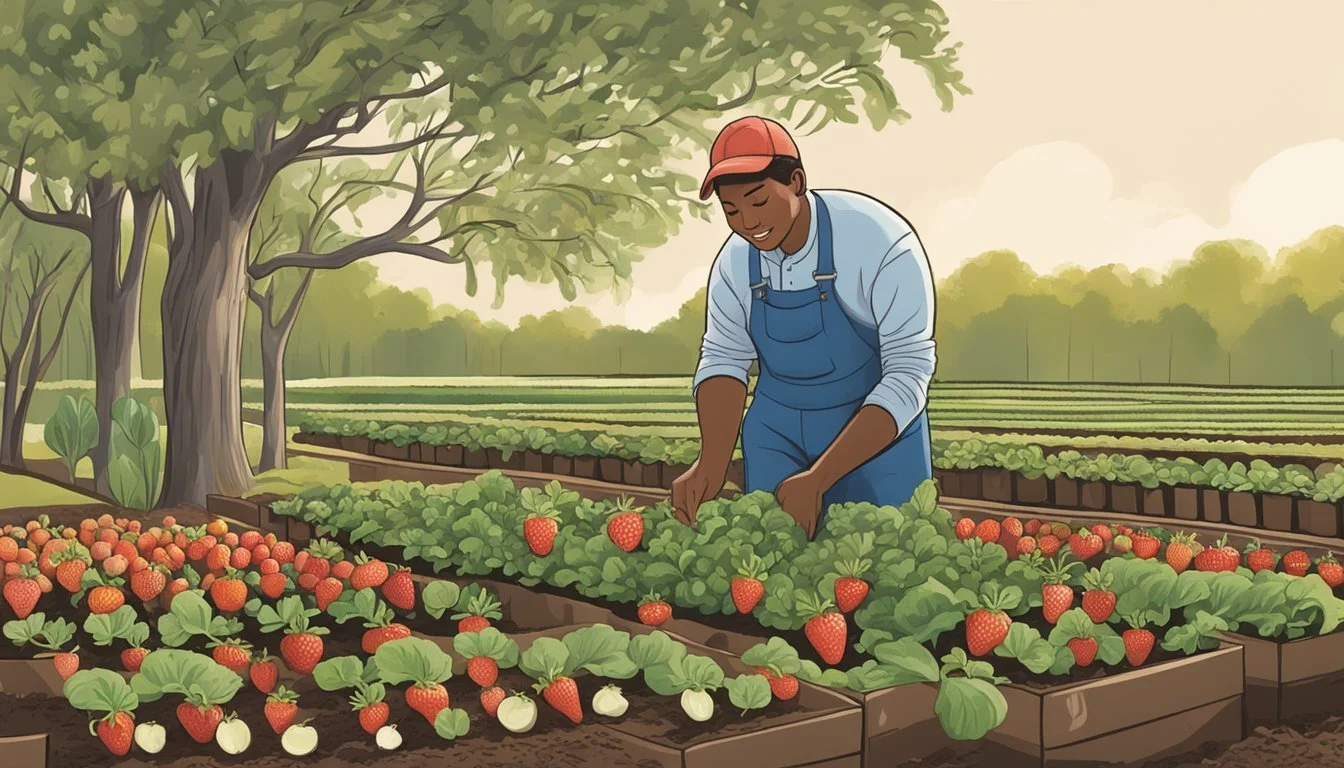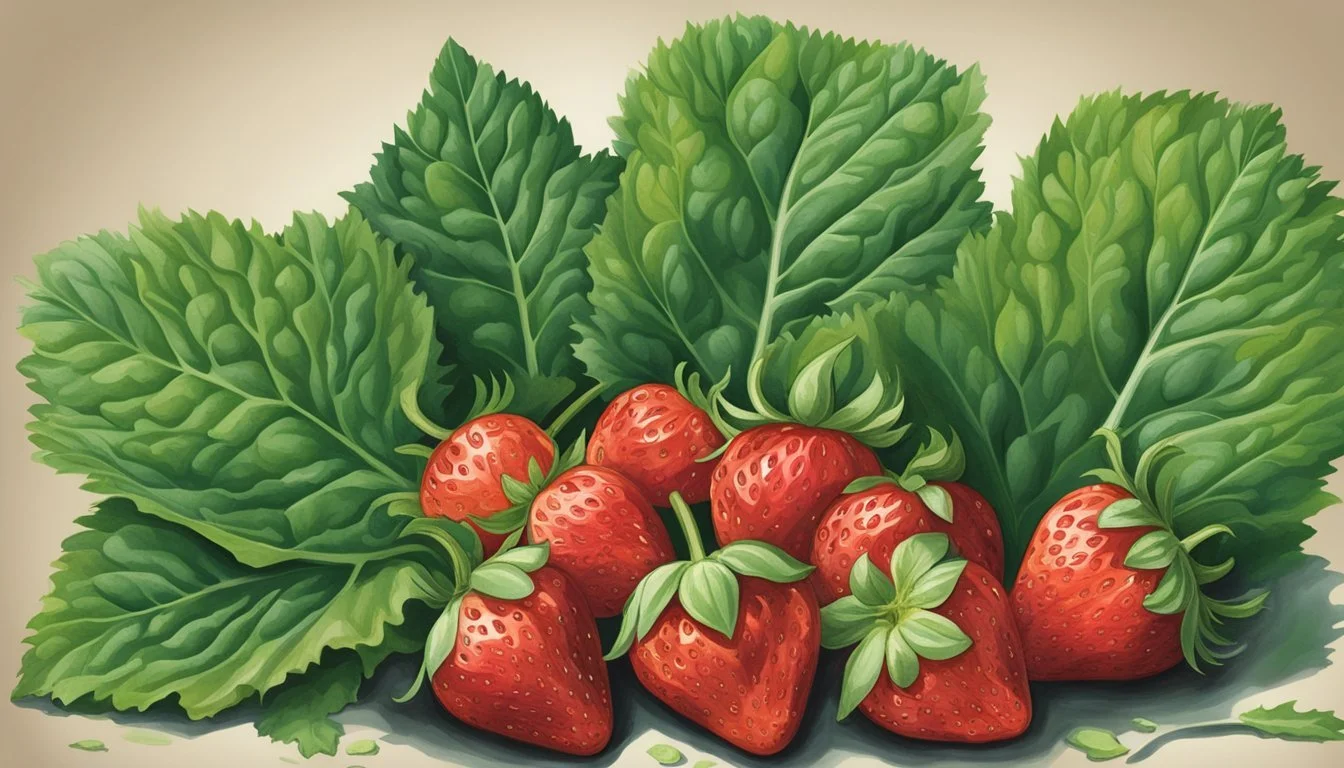Alabama Seasonal Fruit & Vegetables in February
Your Guide to Fresh Produce
This Article is Part of our Alabama Seasonal Fruit & Veg Calendar
February in Alabama is a transitional period for gardening and fresh produce enthusiasts; the state's moderate climate allows for a shift in the range of seasonal fruits (What wine goes well with fruit?) and vegetables available. The winter's cooler temperatures linger, but the early signs of spring begin to influence the produce selection. During this time, gardeners in Alabama can expect to continue harvesting robust winter vegetables, while starting to anticipate the arrival of early spring crops.
Given its diverse agriculture, Alabama's farms supply a variety of fruits and vegetables that thrive in February's conditions. Root vegetables like turnips and sweet potatoes (What wine goes well with sweet potatoes?) are well-suited for the cooler temperatures, often remaining available from fall through winter. Greens such as collard, mustard, and turnip greens, as well as kale and spinach, are typically in abundance due to their cold hardiness. Broccoli (how long does broccoli last?)and lettuce, which include butter, leaf, and romaine, are other vegetables that perform well during this season.
While February is not peak fruit season, Alabama does see the continued availability of some hardy fruit crops. Apples, stored from their harvest in the late summer and fall, often remain accessible through the winter months. Meanwhile, residents and farmers prepare for the spring season ahead, often beginning to plant early crops like strawberries indoors so they can later transplant them outside when the soil warms. The promise of spring lies just around the corner with the progression of February, paving the way for a wider variety of fresh produce options in Alabama.
Overview of Alabama's Seasonal Produce
In February, Alabama offers a variety of seasonal produce, owing to its diverse climate which supports winter harvesting. This month is significant for Alabama's agriculture, as consumers have the opportunity to enjoy fresh, in-season fruits and vegetables.
Significance of Seasonal Harvests
Seasonal harvests in Alabama are highly valued for their contribution to local cuisine and economies. They ensure consumers receive the freshest produce, picked at the peak of ripeness, which optimizes nutritional value and flavor. Harvesting in-season also supports sustainable agriculture practices, reduces transportation costs, and helps in the preservation of the local food culture.
Understanding Alabama's Climate
Alabama's climate plays a pivotal role in determining the variety and availability of produce in February. The state experiences a diverse climate, ranging from the cooler temperatures in the north to a milder winter in the south, allowing for an extended harvest of winter crops. This climate variation across the state facilitates the growth of a wide range of seasonal fruits and vegetables during the winter months.
Seasonal Fruits Available in February
In February, consumers in Alabama can find a selection of fresh fruits, predominantly citrus varieties, which thrive in the cool yet mild winter conditions. Apples, stored from the fall harvest, remain crisp and flavorful.
Citrus Fruits
Blood Oranges: They are particularly notable for their deep red flesh and are rich in antioxidants.
Apples
Stored Varieties: While not harvested during this month, stored apples from the previous season are still available and maintain their quality.
Other Seasonal Fruits
Alabama's February fruit selection is limited due to winter conditions, but some local markets may still offer a variety of overwintered or green-house grown fruits.
Seasonal Vegetables to Harvest in February
Alabama's February garden offers a variety of vegetables ready for harvest, focusing on hardy greens and robust root crops that can withstand the cooler temperatures.
Leafy Greens
Leafy greens can thrive in Alabama's February chill. Gardeners can successfully harvest vegetables such as lettuce and kale. These greens are not only cold-tolerant but continue to grow well in this period.
Lettuce: Includes various types such as Romaine, Butterhead, and Iceberg.
Kale: This nutrient-dense green is available in several varieties, ideal for hearty winter dishes.
Root Vegetables
The cool month is also suitable for harvesting root vegetables that mature slowly and sweeten with the cold.
Radishes: Quick to mature, they offer a spicy kick to winter salads.
Turnips: Their roots are at their best when harvested in February, providing a sweet yet earthy flavor.
Cruciferous Vegetables
These vegetables are known for their health benefits and hardiness during cold seasons.
Cabbage: It can be harvested when the head feels firm and is of an adequate size. It stores well and can be used in a variety of culinary applications.
Harvesting these vegetables in February ensures they are flavorful and nutrient-rich, a testament to their seasonal compatibility with Alabama's climate.
Gardening Tips for February
As February brings variable weather in Alabama, gardeners should focus on soil preparation, timely pruning, and indoor planting to ensure a successful growing season.
Soil Preparation and Fertilizing
Proper soil preparation is essential for a nutrient-rich foundation that supports the growth of seasonal crops. Gardeners should conduct soil testing to determine the soil's pH level and nutrient content, thereby informing the need for amendments or fertilizing. Alabama's Cooperative Extension Service can provide guidance and soil testing kits.
Soil Testing: Evaluate pH and nutrient levels.
Fertilizing: Based on test results, apply appropriate fertilizer.
Pruning and Mulching
Pruning is necessary to maintain plant health and vigor, whereas mulching conserves moisture and regulates soil temperature.
Pruning: Remove dead or diseased branches from trees and shrubs.
Mulching: Apply a layer of organic material to protect against sudden temperature changes.
Indoor Planting Strategies
Gardeners can use February to start a variety of vegetables and herbs indoors under grow lights to get ahead of the planting season.
Vegetables: Tomatoes, Peppers, Broccoli
Herbs: Basil, Parsley, Cilantro
Indoor Plantings allow for an extended growing season and protect young plants from the last frosts of winter.
Planning Your Home Garden
When planning a home garden in Alabama for February, gardeners should focus on selecting appropriate fruits and vegetables for the season, understanding planting timelines to maximize harvest, and utilizing local resources and guides for best practices.
Selecting Vegetables and Fruits
When choosing vegetables and fruits to plant in February in Alabama, it's essential to select varieties that can thrive in the cooler weather and that are suitable for the state's soil and climate conditions. Feasible options include:
Vegetables: Broccoli, Cauliflower, and Carrots
Fruits: It is generally off-season for fruit planting in February, but gardeners can prepare for late spring by selecting and ordering seeds (how long do seeds last?) or saplings.
Local Staples:
Tomatoes: Start seeds indoors to transplant later.
Potatoes: Begin with seed potatoes towards the later part of the month.
Squash: Prepare for planting squash by selecting a sunny location and consider starting seeds indoors.
Understanding Planting Timelines
Planting timelines are crucial to the success of a garden. Gardeners should adhere to the following schedule in February for optimal growth:
Vegetable Activity Timeline Broccoli Plant seedlings Early to mid-February Cauliflower Plant seedlings Early to mid-February Carrots Direct sow into the ground Early February Potatoes Plant seed potatoes Late February
Note: Weather conditions can impact planting dates. Always monitor the local forecast and adjust timelines accordingly.
Local Resources and Guides
Gardeners in Alabama can leverage local resources for information and guidance. Key sources include:
Auburn University's Cooperative Extension: Offers a Gardening Calendar with monthly guidelines on activities like soil testing and planting.
Alabama Department of Agriculture: Provides advice on suitable plant varieties and region-specific tips for gardeners.
Local Nurseries: Engage with experts for advice on local plant varieties, proper fertilizer application, and tailored gardening activities.
It's advised to consult these resources when planning your garden to ensure that you are aligned with the regional best practices for seasonal gardening.
Supporting Local Agriculture
Purchasing seasonal produce from local farmers in Alabama not only guarantees freshness but also bolsters the state's agricultural economy. February offers an array of produce, and buying local ensures that fruits and vegetables are enjoyed when they reach peak ripeness.
Benefits of Buying Local Produce
Seasonality: When consumers buy local, they are purchasing fruits and vegetables that are in season. Seasonal produce tends to be fresher and tastier, as it is sold soon after it's harvested. In February, customers can expect winter crops that have ripened naturally, delivering better flavor and nutrition.
Supporting the Economy: Buying from local farms contributes to the sustainability of the local economy. Funds stay within the community, supporting farmers and allowing them to maintain and improve their agricultural practices.
Finding Local Farms and Markets
Local Farmers' Markets: Check for farmers' markets operating in February. They often provide a variety of seasonal produce directly from local growers.
Farm Stands and Co-ops: These are excellent sources for fresh, local products. Some may operate year-round or have indoor facilities during the colder months.
Community-Supported Agriculture (CSA): Joining a CSA can give consumers direct access to fresh produce from local farms. Shares are typically available for pickup or delivery on a regular schedule.
By supporting local agriculture, consumers ensure that the products they purchase are not only available at their peak season but also contribute positively to the local community and economy.
Alabama Gardener’s Monthly Tasks
In February, gardeners in Alabama focus on maintaining lawns, caring for shrubs, and beginning the early phases of flower and tree planting. Precision and timing are crucial for ensuring a healthy and vibrant garden as the seasons change.
Lawn and Shrub Care
For lawns, February is a prime time for soil testing to determine the need for amendments. Gardeners should test soil pH and nutrient levels to prepare for spring fertilization. February is not typically a major growth month for grass, but it is good practice to clean up any debris on the lawn to prevent diseases and pests.
Shrubs require careful attention to ensure their continued health through the colder days. Pruning is essential but it must be done selectively; gardeners should only prune shrubs if they show signs of winter damage or if they are winter-flowering varieties that have finished blooming.
Flower Gardening
This month, Alabama gardeners prepare beds for annuals and perennials. It's time to:
Clear beds of winter debris.
Amend soil: Introduce compost or other organic matter to improve soil structure and nutrition.
Planning and ordering seeds can start now, particularly for those plants with a longer growth period before they can be transitioned outside.
Gardeners may start indoor seedlings for certain annuals and perennials so they will be ready for transplant once the risk of frost has passed.
Tree and Shrub Plantings
February is an opportune time for gardeners to plant certain nut trees and deciduous shrubs, as the plants are still in dormancy. The Alabama Gardener’s Calendar suggests the following for this period:
Plant new trees and shrubs: Ensure the ground is not frozen and the soil is workable.
Pruning: It is appropriate to prune certain fruiting and nut trees, cutting away any dead or diseased branches.
Gardeners should also offer protection to young trees and shrubs from late winter frosts by using burlap wraps or frost cloths.
Species-Specific Guides
In February, Alabama gardeners focus on maintaining plant health and preparing for the spring. The following guides provide tailored advice for caring for specific heirloom plants, protecting against pests and diseases, and successful propagation techniques.
Care for Heirloom Varieties
Camellias and Heirloom Roses require well-draining soil and should be checked for signs of leaf yellowing or bud drop, indicating watering issues or nutrient deficiencies. Mulching helps retain moisture while providing a temperature buffer for the roots. Dahlias benefit from a sheltered position that provides protection from strong winds and heavy frost.
Managing Pests and Disease
Gardeners must remain vigilant against pests and diseases. For Strawberries, slugs can be a common problem; setting up slug traps early in the season is advisable. Collards may attract aphids; a strong water spray or organic insecticides can be effective in managing these pests. Regular inspection of all plants for signs of disease, such as mildew or black spot—particularly prevalent on Heirloom Roses—allows for early treatment with fungicides or removal of affected foliage.
Propagating Plants
Propagation ensures the survival and spread of heirloom varieties like Camellias and Heirloom Roses. They can be propagated by cuttings, with the cuttings taken in February requiring protection until they can be planted out after the last frost. Kohlrabi and Beets can be directly sown into the ground or started indoors for transplanting later in the season. It's essential for seeds to have consistent moisture and warmth to germinate effectively.
Alabama's Diverse Fruit and Vegetables Calendar
Alabama offers a rich tapestry of fruits and vegetables throughout the year, each season bringing its unique planting and harvesting opportunities. Proper planning and consideration for each season will yield the best produce for both home gardeners and commercial farmers.
Spring Planning for Harvest
Sweet Potatoes: Gardeners should start preparations for sweet potatoes in late spring, as they require a longer growing season. The tender roots of sweet potatoes need a frost-free period of about 150 days.
Green Beans: These can be planted as early as March in South Alabama and a bit later in the North. The spring crop will benefit from cooler temperatures before the heat of summer sets in.
Summer Planting Considerations
Sweet Corn: February marks the time when farmers should begin planning their sweet corn plantings. As one of the quintessential summer vegetables, it should be planted after the last spring frost, typically between March and April, but plans need to be set in February.
Watermelons: Watermelon planting usually starts in April; however, wise growers consider their varieties and plot locations well before this month. Proper planning ensures the ground will be warm enough to foster growth for these heat-loving fruits.
Eggplants and Peppers: These vegetables should be planted after the danger of frost has passed and the soil has warmed up. February serves as a key planning month to ensure a successful summer harvest.
Fall and Winter Tips
Green Beans: Plantings can continue until August, but farmers are encouraged to start plotting their fall green bean plantings as early as February for an October harvest.
Sweet Potatoes: They need to be harvested before the first frost in fall, thus precluding them from fall planting but making the end of summer the season to keep an eye on their maturity.
By considering the particular needs of each fruit and vegetable during their respective planting and harvesting seasons, Alabama's farmers can maximize their yield and enjoy the bounties of their labor throughout the year.
Expert Contributions
Renowned horticulturists, including Kerry Smith and Frances Sledge, underscore the significance of observing local seasonal calendars to maximize the productivity and nutritional value of the produce in Alabama. Smith's extensive work on planting schedules provides valuable insights into the optimal time frames for sowing and harvesting crops in the state.
Frances Sledge's research complements this by demonstrating efficient garden management techniques for local conditions. She emphasizes the need for proper planning in February, considering Alabama's unique soil and climate.
Agricultural expert Dave Williams offers pragmatic advice on the cultivation of winter vegetables, which can still be harvested in February. With emphasis on soil health, he provides guidance on mulching and the use of cover crops to protect and enrich the soil during colder months, ensuring a robust yield.
Entomologist Ron Shumack focuses on pest management during this transitional period. He elaborates on organic methods to deter common pests that can affect Alabama's February crops. Shumack's strategies prioritize environmental sustainability while maintaining the health of both plants and consumers.
Expert Name Contribution Focus Noteworthy Advice Kerry Smith Planting Schedules Optimal sowing and harvesting time frames Frances Sledge Garden Management February planning for soil and climate Dave Williams Soil Health & Cultivation Winter vegetable cultivation; mulching techniques Ron Shumack Pest Management Organic pest deterrence methods
Their combined expertise ensures that growers in Alabama are well-informed and prepared to manage their gardens effectively during February, leveraging Alabama's growing conditions for a successful season.

